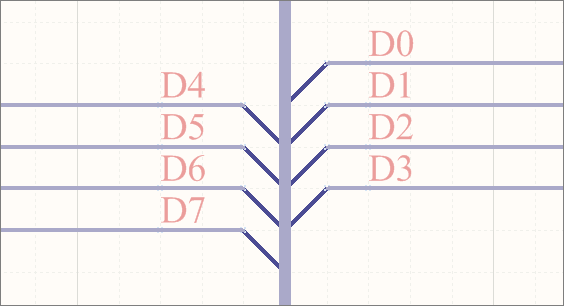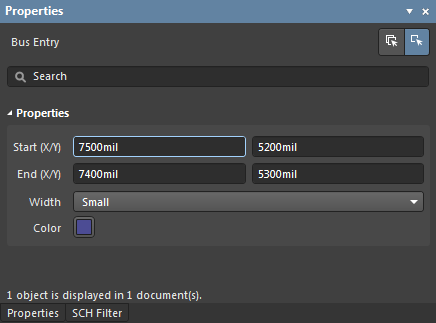Working with a Bus Entry Object on a Schematic Sheet in Altium Designer
Parent page: Schematic Objects
 Bus Entries can be used to connect Wires to a Bus.
Bus Entries can be used to connect Wires to a Bus.
Summary
A Bus Entry is an electrical design primitive that is used to connect a Wire to a Bus line. It has the ability to allow two different nets to connect to the same point on a Bus – if this was done using Wires, the two nets would short. If this capability is not required, bus entries do not need to be used.
Availability
Bus entries are available for placement in the Schematic Editor only by:
- Choosing Place » Bus Entry from the main menus.
- Clicking the Bus Entry button (
 ) in the net wiring objects drop-down on the Active Bar located at the top of the workspace. Click and hold an Active Bar button to access other related commands. Once a command has been used, it will become the topmost item on that section of the Active Bar.
) in the net wiring objects drop-down on the Active Bar located at the top of the workspace. Click and hold an Active Bar button to access other related commands. Once a command has been used, it will become the topmost item on that section of the Active Bar. - Clicking the
 button on the Wiring toolbar (click View » Toolbars » Wiring to activate) .
button on the Wiring toolbar (click View » Toolbars » Wiring to activate) . - Right-clicking then choosing Place » Bus Entry from the context menu.
Placement
After launching the command, the cursor will change to a cross-hair and you will enter Bus Entry placement mode.
- Click or press Enter to place a Bus Entry at the cursor position.
- Press Spacebar to rotate the Bus Entry counterclockwise (in increments of 90°) or press Shift+Spacebar to rotate clockwise.
- Press the X or Y keys while in placement mode to mirror the Bus Entry along the X-axis or Y-axis.
- Continue placing bus entries or right-click or press Esc to exit placement mode.
During placement, press the Tab key to pause the process and access the Bus Entry mode of the Properties panel from where its line properties can be changed on-the-fly. Click the workspace pause button overlay (  ) to resume placement.
) to resume placement.
Graphical Editing
To move a Bus Entry, click and hold on it (the cursor will jump to the nearest electrical hotspot), then move it to the new location – connected Buses and Wires will remain attached. While moving the Bus Entry, use the X and Y keys to change the Bus Entry orientation on those axes.
Non-Graphical Editing
The following methods of non-graphical editing are available:
Via the Properties Panel
Panel page: Bus Entry Properties
This method of editing uses the associated Properties panel mode to modify the properties of a Bus Entry object.
 The Bus Entry mode of the Properties panel.
The Bus Entry mode of the Properties panel.
During placement, the Bus Entry mode of the Properties panel can be accessed by pressing the Tab key.
After placement, the Bus Entry mode of the Properties panel can be accessed in one of the following ways:
- Double-clicking on the placed Bus Entry object.
- Placing the cursor over the Bus Entry object, right-clicking then choosing Properties from the context menu.
- If the Properties panel is already active, by selecting the Bus Entry object.
Editing Multiple objects
The Properties panel supports multiple object editing, where the property settings that are identical in all currently selected objects may be modified. When multiples of the same object type are selected manually, via the Find Similar Objects dialog or through a Filter or List panel, a Properties panel field entry that is not shown as an asterisk (*) may be edited for all selected objects.
Via the SCH List Panel
Panel pages: SCH List, SCH Filter
A List panel displays design object types from one or more documents in tabular format, enabling quick inspection and modification of object attributes.
Used in conjunction with appropriate filtering – by selecting object types (using the panel's Include options), or by using the applicable Filter panel or the Find Similar Objects dialog – it enables the display of just those objects falling under the scope of the active filter. The properties for all the listed objects may then be edited directly in the List panel.
